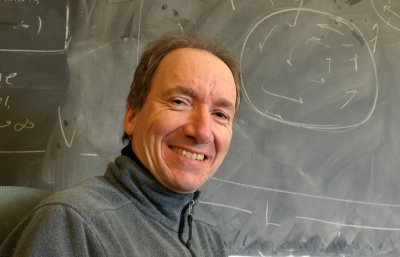 EUGENE, Ore. -- (Feb. 24, 2011) -- Neither births nor deaths stop the flocking of organisms. They just keep moving, says theoretical physicist John J. Toner of the University of Oregon. The notion, he says, has implications in biology and eventually could point to new cancer therapies.
EUGENE, Ore. -- (Feb. 24, 2011) -- Neither births nor deaths stop the flocking of organisms. They just keep moving, says theoretical physicist John J. Toner of the University of Oregon. The notion, he says, has implications in biology and eventually could point to new cancer therapies.
Picture any scenario in which self-propelled organisms -- animals, birds, bacteria, molecules within cells, cancer cells, fish, and even tiny plastic rods on a vibrating table -- move as a swarm or flock in the same direction. Eighteen years ago, Toner co-developed two equations that together provide a complete theory of flocking for "immortal" flocks -- those in which creatures are not being born and dying while moving.
Now he has extended that work to include the effects of birth and death.
Audio:
► (63 seconds) Toner describes the concept of flocking
► (55 seconds) Toner summarizes his new paper
The new equations are as complete a description of flocks as the Navier-Stokes equation is of fluid dynamics. This equation, named after French physicist and engineer Claude-Louis Navier and British scientist George Gabriel Stokes applies equally well to all fluids; air, water, honey and the oil from the Gulf of Mexico disaster are all described by it. All of the differences between these very different fluids can be incorporated into the Navier-Stokes equation by changing the value of one number, called "the viscosity." Large values apply to sticky fluids like honey and oil, while smaller values describe air and water.
The Navier-Stokes equation has been used successfully for more than a century in the design of aircraft, automobiles, plumbing and power stations.
Toner's equations likewise work for all flocks, and contain some numbers that must be adjusted to account for differences between different kinds of flocks. The earlier work on immortal flocks has been applied to the flocking behavior of birds, particularly studies of starlings in Rome by Andrea Cavagna and Irene Giardina.
In a new paper -- "Birth, Death, and Flight: A Theory of Malthusian Flocks," published in the Feb. 24 issue of the journal Physical Review Letters -- Toner shows that flocking is even robust against birth and death. The finding, he said, is especially important for many other organisms that flock, especially bacteria, which may contain millions of individuals that are constantly dying and being replaced by the reproduction of others as the swarm moves.
"A flock can keep moving in the same direction for times much longer than the lifetime of any individual member," said Toner, a member of the UO Institute of Theoretical Science and a professor in the physics department. "Individuals are being born and dying but their direction and motion can persist much longer than the lifetime of any individual creature."
Secondly, he added, the density changes of such a "mortal flock" -- where some members are leaving by death and joining by birth -- create persistent but predictable fluctuations. "Birth and death are very important in microbiological flocks, such as swarms of bacteria or in collections of self-propelled molecules that flock in most living cells."
This fundamental new knowledge already is applicable to understanding the movement of molecules within cells -- in particular, mitotic spindles that launch the machinery of cell development and division, Toner said.
In mitotic spindles, individual molecules live for only about 20 minutes, but spindles live and continue their work for days, he said. "The motion continues as dead molecules are replaced by newly synthesized molecules, as well as by molecules which immigrate in to take their places."
Through the application of his new theory to the study of mitotic spindles, Toner said, it may be possible to design specifically targeted cancer therapies that, unlike current chemotherapies, would only kill aberrant, or diseased cells, and allow desirable, healthy ones to live. "In reality, such applications are a long way off," said Toner, whose research is supported by the National Science Foundation.
In September, Toner will embark on a one-year sabbatical to do additional research on flocking, or collective behavior, at IBM Yorktown Heights and the University of California, Berkeley, under a fellowship from the New York City-based Simons Foundation.
About the University of Oregon
The University of Oregon is among the 108 institutions chosen from 4,633 U.S. universities for top-tier designation of "Very High Research Activity" in the 2010 Carnegie Classification of Institutions of Higher Education. The UO also is one of two Pacific Northwest members of the Association of American Universities.
Media Contact: Jim Barlow, director of science and research communications, 541-346-3481, jebarlow@uoregon.edu
Source: John Toner, professor of physics, 541-346-0979, jjt@uoregon.edu
UO Science on Facebook
Note: The University of Oregon is equipped with an on-campus television studio with satellite uplink capacity, and a radio studio with an ISDN phone line for broadcast-quality radio interviews. Call the Media Contact above to begin the process.